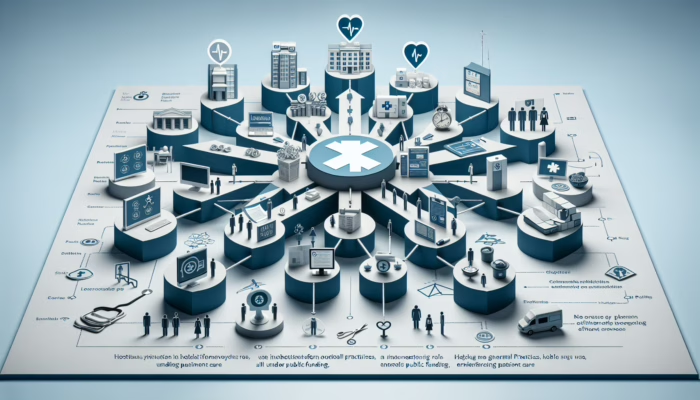Unpacking the Intricacies of the UK Healthcare Framework
The UK healthcare system represents a complex and multifaceted structure, significantly shaped by the operations of the National Health Service (NHS) alongside a rapidly expanding private healthcare sector. When embarking on the essential journey of developing a compelling value proposition for your healthcare startup, it is vital to explore these dynamics thoroughly. This exploration will illuminate both the opportunities that exist and the challenges that must be navigated in this continually evolving landscape.
Understanding the Structure and Services Provided by the NHS
The National Health Service, commonly known as the NHS, is the cornerstone of healthcare provision in the United Kingdom. This publicly funded entity offers an extensive range of health services that are provided free at the point of use to all residents, embodying the principle of universal healthcare. The NHS is segmented into four distinct bodies across England, Scotland, Wales, and Northern Ireland, with each operating under its own governance and management frameworks. For instance, in England, NHS England oversees the distribution of funds to various Clinical Commissioning Groups (CCGs), which are responsible for commissioning local healthcare services tailored to community needs.
The breadth of services rendered by the NHS is vast and includes general practitioner (GP) services, emergency care, hospital treatments, mental health services, and preventative care. The overarching mission of the NHS is to address the healthcare requirements of the entire population, reinforcing its position as a pivotal entity within the UK healthcare ecosystem. For entrepreneurs in the healthcare startup scene, it is crucial to consider how your offerings can enhance or complement the existing services provided by the NHS, particularly in sectors where patients frequently face extended waiting times or limited access to necessary care.
Additionally, the integration of social care with public health initiatives highlights the NHS’s commitment to a comprehensive approach to health. By gaining a thorough understanding of this organisational structure, you will be equipped to tailor your unique value proposition to address specific gaps where the NHS may not completely fulfil patient needs, thus positioning your startup as a vital adjunct to the current healthcare services available.
Analysing the Expansion of the Private Healthcare Sector
The private healthcare sector in the UK has witnessed substantial growth, presenting viable alternatives to NHS services for those seeking them. Prominent private providers such as Bupa, Spire Healthcare, and Nuffield Health cater to individuals who are in pursuit of prompt care, specialised treatments, and enhanced comfort throughout their healthcare experiences. These organisations significantly influence the UK health landscape by delivering services that often promise shorter waiting times and a more tailored patient experience.
Private healthcare particularly attracts individuals with the financial capacity to access such services, enabling quicker access to elective surgeries, advanced diagnostics, and customised health programmes. As you conceptualise your healthcare startup, it is vital to assess how your services can be tailored to appeal to this demographic. This could include developing innovative financing options or packages designed to make private healthcare more accessible to a broader audience.
Moreover, recent trends indicate an increasing interest in preventive health and wellness services within the private sector. This shift opens up numerous avenues for startups to introduce innovative solutions that prioritise wellness and early intervention, aligning with consumer demands for proactive health management and comprehensive care.
Understanding the Regulatory Landscape in UK Healthcare
Successfully navigating the regulatory landscape is crucial for any healthcare startup operating within the UK. The Care Quality Commission (CQC) plays a key role in regulating and inspecting health and social care services, ensuring compliance with established standards. Adhering to the regulations set forth by the CQC and other regulatory authorities, such as the Medicines and Healthcare products Regulatory Agency (MHRA), is vital for establishing trust and credibility in a competitive healthcare marketplace.
It is essential to comprehend the fundamental compliance requirements, including securing necessary registrations and adhering to data protection laws such as the General Data Protection Regulation (GDPR). Your unique value proposition should not only highlight the quality and efficacy of your services but also demonstrate your commitment to regulatory compliance and patient safety. Showcasing this diligence can significantly distinguish your startup from competitors who may overlook these critical aspects of healthcare operation.
In addition to national regulations, it is important to remain cognizant of local policies and guidelines that could affect your business operations. Collaborating with legal experts and consultants can provide invaluable insights into navigating the intricate landscape of healthcare regulations. By prioritising compliance and quality assurance, you position your startup as a trustworthy provider in the perception of both consumers and regulatory entities.
Identifying and Addressing Specific Healthcare Needs in the UK
Acquiring a comprehensive understanding of the specific healthcare needs of the UK population is fundamental for developing an effective value proposition for your healthcare startup. As demographics shift and health issues evolve, tailoring your services to adequately meet these demands will markedly enhance your startup’s relevance and operational efficiency.
Recognising Common Health Issues Affecting the UK Population
The UK faces several prevalent health concerns that present both challenges and opportunities for healthcare startups. Conditions such as cardiovascular diseases, diabetes, and mental health disorders rank among the leading causes of morbidity and mortality across the nation. For instance, the NHS reports that one in four adults will experience mental health issues at some point in their lives, highlighting a critical area where your startup can make a significant difference.
By directly tackling these common health issues, your startup can develop targeted solutions that resonate with the population’s urgent health needs. Innovative digital health tools, for instance, can facilitate early detection and ongoing management of chronic conditions, potentially relieving pressure on NHS resources. Consider designing platforms that offer personalised health assessments, remote monitoring capabilities, and access to specialist consultations, empowering patients to take charge of their healthcare journey.
Furthermore, the rising incidence of lifestyle-related diseases underscores the necessity of implementing preventive healthcare strategies. Your startup could concentrate on promoting wellness programmes that advocate healthy living through exercise, nutrition, and mental well-being initiatives. By aligning your services with the pressing health concerns faced by the UK population, you can significantly increase your chances of success and long-term sustainability.
Investigating Demographic Trends and Their Influence on Healthcare
Demographic trends within the UK are undergoing significant transformations, with an ageing population and increasing diversity presenting unique healthcare challenges. According to the Office for National Statistics (ONS), the number of individuals aged 65 and over is projected to rise considerably, necessitating healthcare solutions tailored specifically to meet this demographic’s unique needs.
As the population ages, there will be an escalating demand for services related to chronic disease management, rehabilitation, and palliative care. Your startup can flourish by designing services specifically aimed at older adults, such as in-home care solutions, telehealth services that reduce the need for travel, or community-based support systems that foster social connections and combat loneliness.
Additionally, the growing diversity within the UK population calls for culturally sensitive healthcare solutions. By recognising the unique backgrounds and experiences of various communities, your startup can offer tailored services that resonate with a wider audience. This could involve providing language support, culturally relevant health education, and outreach programmes aimed at underserved populations.
Understanding Regional Variations in Health Disparities
Regional health disparities add another layer of complexity to the UK healthcare landscape. Certain areas, such as the North East, may experience higher levels of health inequalities compared to their counterparts in the South East. Factors such as socioeconomic status, access to healthcare facilities, and lifestyle choices contribute to these disparities.
As a healthcare startup, understanding these regional variations enables you to tailor your services to effectively meet local needs. Conducting comprehensive market research to identify specific health trends and concerns in different regions will empower you to develop targeted interventions. For example, if a particular area has a high prevalence of obesity, your startup could introduce community-based weight management programmes or nutrition education initiatives to address this pressing issue.
Moreover, collaborating with local healthcare providers and organisations can enhance your startup’s credibility while ensuring that your services genuinely address community needs. By considering regional disparities, you not only enhance your startup’s relevance but also contribute to bridging the healthcare gap within the UK.
Assessing the Competitive Landscape in UK Healthcare
In the competitive arena of UK healthcare, understanding your competitors is essential for establishing a successful startup. Analysing existing players and their value propositions will yield insights into how your offerings can stand out and fulfil unmet needs within the market.
Identifying Key Players in the UK Healthcare Market
The UK healthcare market encompasses numerous established players, spanning both the NHS and private sectors. Major NHS trusts and private healthcare organisations, such as Bupa and the NHS itself, provide a diverse range of services, each with its unique value proposition. It is crucial to investigate the strengths and weaknesses of these organisations, including their service delivery models, patient engagement strategies, and overall customer satisfaction ratings.
For instance, some private providers focus on luxury offerings, such as high-end facilities and expedited access to specialists. In contrast, NHS services often prioritise accessibility and comprehensive care. Grasping these dynamics allows your startup to carve out a niche by presenting a unique combination of accessibility, affordability, and quality that resonates with the market.
Furthermore, delving into patient reviews and feedback can provide invaluable insights into what consumers appreciate or find lacking in existing services. This information can inform your own value proposition, helping you position your startup as a customer-centric alternative. Emphasising a commitment to patient satisfaction and quality care can significantly enhance your appeal in an increasingly crowded marketplace.
Discovering Niche Market Opportunities
Identifying niche market opportunities is crucial for differentiating your healthcare startup within the UK. While established players may dominate certain sectors of the market, many areas remain underserved. For instance, telehealth services have surged in popularity, yet specific segments such as remote monitoring for chronic conditions or personalised mental health support may still exhibit significant gaps.
Thorough market research can unveil unique opportunities that align with your startup’s vision. Consider focusing on underserved demographics, such as rural populations who encounter challenges accessing care, or specific cultural communities requiring tailored health services. Developing solutions that cater to these niches not only boosts your chances of success but also allows you to make a meaningful impact on the health of these communities.
Additionally, exploring partnerships with local organisations can facilitate entry into these niche markets, providing access to established networks and expertise. By positioning your startup as a specialist in a specific area, you can attract a loyal customer base that often goes overlooked by larger competitors.
Assessing Competitor Strengths and Weaknesses
Conducting a thorough analysis of your competitors’ strengths and weaknesses will empower you to identify your unique competitive advantage. For instance, while established players may possess extensive resources, they might struggle with innovation or responsiveness to patient needs due to bureaucratic processes. Your startup, being smaller and more agile, can capitalise on this by offering personalised services and rapid adaptations to consumer feedback.
Identifying competitors’ weaknesses also enables you to pinpoint gaps in the market that your startup can effectively fill. For example, if there is a lack of emphasis on mental health services among traditional providers, your startup could concentrate on delivering innovative mental health solutions that prioritise accessibility and patient engagement.
Moreover, understanding competitors’ marketing strategies can inform your approach. If certain providers heavily rely on traditional advertising, your startup could leverage digital marketing and social media to connect with a tech-savvy audience seeking modern healthcare solutions. By being aware of the competitive landscape, you can strategically position your startup for optimal visibility and success.
Crafting Your Value Proposition for the UK Market
Creating a compelling value proposition is crucial for your healthcare startup’s success within the UK market. Your value proposition must clearly articulate what makes your services distinct and how they effectively address the specific needs and expectations of UK consumers.
Defining Your Unique Selling Points (USPs)
Establishing your unique selling points (USPs) involves identifying the characteristics that distinguish your healthcare startup from competitors. This could include innovative technologies, specialised services, or a novel approach to patient care. For instance, if your startup leverages artificial intelligence to enhance diagnostic accuracy, this advanced technology could serve as a significant USP.
Moreover, consider how your USPs resonate with the UK market. For example, emphasising a commitment to sustainability and environmental responsibility could appeal to the growing number of consumers prioritising eco-friendly choices. Highlighting partnerships with local organisations or community initiatives can further amplify your appeal, showcasing your dedication to making a positive impact on society and public health.
Your USPs should be communicated clearly across all marketing channels, ensuring that potential customers grasp the unique benefits of choosing your services. By establishing a strong and differentiated identity, you can cultivate a loyal customer base that values the distinctive offerings of your startup.
Addressing UK Customer Pain Points Directly
To create a truly effective value proposition, your startup must directly address the specific pain points faced by UK healthcare consumers. Common frustrations include long waiting times for NHS services, a lack of personalised care, and limited access to specialists. Your startup can tackle these challenges by offering solutions prioritising convenience, accessibility, and the quality of care.
For instance, if your service includes online consultations with specialists, this can alleviate the burden of travel and long wait times. By providing a seamless user experience that is both intuitive and efficient, you can position your startup as a solution that genuinely prioritises patients’ needs.
Additionally, consider enhancing patient education and empowerment through your services. Providing resources that inform patients about their conditions, treatment options, and self-care strategies can foster a sense of control and engagement. By directly addressing these pain points, your value proposition becomes more relevant and compelling, driving customer loyalty and satisfaction.
Aligning with Current Healthcare Trends in the UK
Staying attuned to current and emerging trends in UK healthcare is vital for maintaining the relevance of your value proposition. The increasing emphasis on digital health technologies, personalised medicine, and preventative care reflects the changing priorities of both patients and healthcare providers.
For example, integrating digital health tools into your offerings can enhance patient engagement and streamline care delivery. This might include mobile health applications that enable patients to track their health metrics, receive medication reminders, or access virtual consultations. By proactively embracing these trends, your startup can position itself as a forward-thinking provider attuned to the evolving needs of UK consumers.
Moreover, consider how your value proposition can adapt to anticipate future healthcare trends. As demand for preventative care escalates, your startup could introduce wellness programmes or lifestyle management services that empower patients to take charge of their health. By aligning your offerings with both current and future trends, you can ensure that your startup remains competitive and relevant in the dynamic UK healthcare market.
Harnessing Technology and Innovation in UK Healthcare
In the rapidly evolving healthcare landscape, leveraging technology and innovation is essential for enhancing your startup’s value proposition. The UK is at the forefront of health tech advancements, presenting numerous opportunities for startups to integrate cutting-edge solutions into their service offerings.
Implementing Digital Health Solutions
Digital health solutions have gained remarkable traction in the UK, propelled by technological advancements and changing consumer expectations. From telehealth services to mobile health applications, these tools facilitate more accessible and efficient healthcare delivery. As you develop your startup, consider how integrating digital health solutions can elevate your unique value proposition.
For example, telemedicine platforms enable patients to consult with healthcare professionals from the comfort of their homes, thereby reducing barriers to access. By offering virtual consultations, your startup can cater to busy individuals who may struggle to visit traditional healthcare settings. Additionally, implementing remote monitoring tools can empower patients with chronic conditions to proactively manage their health, further enhancing their experience with your services.
Furthermore, contemplate how your startup can leverage data to improve patient outcomes. By analysing health metrics collected through digital tools, you can provide tailored recommendations and interventions that resonate with individual patient needs. This data-driven approach not only enhances the quality of care but also positions your startup as an innovative leader in the healthcare sector.
Collaborating with UK-Based Research and Development Entities
Partnering with UK research institutions can significantly enhance the innovative capabilities of your healthcare startup. The UK is home to world-class universities and research centres, which are at the forefront of health-related studies and technological advancements. By collaborating with these institutions, your startup can leverage cutting-edge research to inform your services and drive innovation.
For instance, consider engaging in clinical trials or research projects that explore the efficacy of new treatments or technologies. Such collaboration not only bolsters your credibility but also positions your startup as a contributor to the advancement of healthcare knowledge. Additionally, access to the latest research findings can inform your service offerings, ensuring they are evidence-based and effective.
Moreover, connecting with local innovation hubs or accelerators can provide invaluable support in refining your startup’s business model and technology. These resources typically offer mentorship, funding opportunities, and networking connections that can catalyse your growth and success in the competitive healthcare market.
Exploring Telemedicine and Remote Care Solutions
The rise of telemedicine and remote care solutions has fundamentally transformed the delivery of healthcare in the UK. With the growing adoption of smartphones and digital devices, patients increasingly expect convenient and accessible healthcare options. Your startup can capitalise on this trend by integrating telemedicine solutions into your service offerings.
By providing virtual consultations, remote monitoring, and digital health tools, your startup can enhance patient convenience and satisfaction. For example, a platform that connects patients with specialists for video consultations can significantly reduce waiting times and expand access to care for individuals in remote or underserved areas.
Furthermore, incorporating remote care strategies into your value proposition can improve chronic disease management, allowing patients to receive timely interventions and support without the need for frequent in-person visits. This not only enhances patient outcomes but also positions your startup as a forward-thinking entity in the healthcare arena.
Integrating AI and Machine Learning into Healthcare Applications
Artificial intelligence (AI) and machine learning technologies are revolutionising healthcare, presenting new pathways for improving diagnostics and patient outcomes. Your startup can harness these advanced technologies to enhance its services and distinguish itself within the UK market.
For instance, AI algorithms can be employed for predictive analytics, identifying potential health risks based on patient data and history. This proactive approach enables timely interventions and personalised care plans that address individual patient needs. By incorporating AI-driven solutions, your startup can not only improve health outcomes but also streamline operational efficiencies.
Additionally, machine learning can enhance the accuracy of diagnostics by analysing medical images or patient data to identify patterns and trends. By integrating these technologies into your service offerings, you position your startup as a leader in innovation, addressing the growing demand for data-driven healthcare solutions.
Effectively Marketing Your Unique Value Proposition in the UK
Successfully marketing your unique value proposition is essential for gaining traction in the competitive UK healthcare market. Developing targeted marketing strategies that resonate with your audience will drive awareness and engagement for your startup.
Implementing Targeted Advertising Strategies in the UK
To effectively reach your target audience, it is crucial to employ targeted advertising strategies that resonate with UK consumers. Utilising digital advertising platforms, such as Google Ads and various social media channels, allows you to create tailored campaigns that speak directly to your audience’s needs and preferences.
Consider segmenting your audience based on demographics, behaviours, and health interests to create personalised advertising messages. For instance, if your startup offers mental health services, targeting specific groups, such as young adults or working professionals, can enhance the relevance of your ads. This approach increases the likelihood of engagement and conversion, as potential customers encounter messages that resonate with their unique circumstances.
Moreover, leveraging local SEO strategies will enhance your visibility within specific geographical areas. By optimising your content for local search terms and integrating location-based keywords, your startup can attract individuals actively seeking healthcare services in their vicinity. These targeted advertising efforts will amplify your startup’s reach, ensuring that your unique value proposition is presented to those who need it most.
Building Strategic Partnerships within the UK Healthcare Ecosystem
Establishing strategic partnerships with recognised UK healthcare providers and institutions can significantly enhance your startup’s credibility and reach. Collaborating with hospitals, clinics, or community organisations allows you to tap into existing networks and gain access to valuable resources.
Consider partnering with local NHS trusts to provide complementary services or support initiatives that align with their goals. For example, if your startup offers a digital platform for managing chronic conditions, collaborating with NHS providers can enhance patient access to your services while reinforcing your commitment to community health and collaborative care.
Additionally, forming alliances with other healthcare startups can foster knowledge-sharing and collaboration, allowing you to pool resources and expertise. By building a robust network of partnerships, your startup can enhance its credibility and position itself as a trusted player within the UK healthcare landscape.
Engaging Actively with UK Communities
Engagement with local communities is crucial for promoting your healthcare services and building trust with potential customers. Hosting community events, health fairs, or informational workshops can provide valuable opportunities to connect with individuals and showcase the benefits of your offerings.
Consider collaborating with local charities or health organisations to reach underserved populations. By demonstrating a genuine commitment to community health, your startup can build a positive reputation and foster goodwill among potential customers. Engaging with communities not only enhances visibility but also positions your startup as a dedicated partner in improving health outcomes and addressing local health disparities.
Furthermore, utilising social media platforms to share educational content, success stories, and patient testimonials can deepen your connection with your audience. By fostering a sense of community online, your startup can establish a loyal following and encourage word-of-mouth referrals that drive growth and engagement.
Maximising Visibility through UK Digital Platforms
Utilising popular digital platforms in the UK is vital for enhancing the visibility of your healthcare startup. Platforms such as Facebook, Instagram, and LinkedIn offer unique opportunities to connect with diverse audiences and promote your value proposition effectively.
Consider creating engaging content that addresses common health concerns, shares patient success stories, and highlights the benefits of your services. Video content, infographics, and live Q&A sessions can increase engagement and foster a sense of community among your audience. By consistently providing valuable information, your startup can establish itself as a trusted source of healthcare knowledge and support.
Moreover, leveraging online reviews and testimonials can enhance your startup’s credibility. Encourage satisfied customers to share their experiences on digital platforms, allowing prospective clients to see the positive impact of your services. By actively engaging with your audience and utilising digital platforms effectively, your startup can significantly increase awareness and interest in your unique offerings.
Measuring Success in the UK Market
Establishing key performance indicators (KPIs) and evaluating success is crucial for the sustainability and growth of your healthcare startup in the UK market. By defining clear metrics, you can assess your performance and make informed decisions to refine your value proposition.
Identifying Key Performance Indicators (KPIs)
Identifying relevant KPIs is essential for assessing your healthcare startup’s performance in the UK. Common metrics may include patient engagement levels, service utilisation rates, and customer satisfaction scores. By regularly tracking these indicators, you can gauge the effectiveness of your strategies and identify areas for improvement.
For instance, monitoring patient retention rates can provide insights into the effectiveness of your services and the overall patient experience. If you notice a decline in retention, it may indicate the need for further enhancements or adjustments to your offerings. Additionally, tracking conversion rates from your marketing campaigns can inform your advertising strategies, helping you optimise your messaging for better results.
Moreover, consider establishing benchmarks based on industry standards to evaluate your performance relative to competitors. This comparative analysis can offer valuable insights into areas where your startup excels or requires improvement, enabling you to adapt your strategies accordingly and maintain a competitive edge.
Gathering Customer Feedback and Assessing Satisfaction
Gathering and analysing feedback from UK customers is vital for refining your value proposition and enhancing patient satisfaction. Implementing feedback mechanisms, such as surveys or post-service follow-ups, allows you to gain insights into the patient experience and identify areas for improvement.
Paying close attention to recurring themes in customer feedback can inform enhancements to your services. For example, if multiple patients express a desire for more educational resources, consider developing materials that address their concerns and empower them to take control of their health. By actively responding to customer feedback, your startup demonstrates a commitment to continuous improvement and patient-centred care, which can significantly enhance patient loyalty and satisfaction.
Additionally, leveraging social media platforms to engage with customers and gather feedback can enhance your startup’s responsiveness. Encourage open conversations and actively address customer concerns, fostering a sense of community and trust among your audience.
Adapting to Changes in the UK Market
The UK healthcare landscape is continually changing, influenced by shifts in regulations, technology, and consumer preferences. As a healthcare startup, it is essential to remain adaptable and responsive to these market dynamics.
Monitoring industry trends and developments, such as changes in policy or emerging technologies, allows you to proactively adjust your services and strategies. For instance, if telehealth becomes increasingly popular due to evolving consumer behaviours, consider expanding your offerings in this area to meet growing demand and patient expectations.
Moreover, regularly reviewing and updating your value proposition based on patient needs and market dynamics will enhance your startup’s relevance. By remaining attuned to changes in the healthcare landscape, you can ensure your startup continues to thrive and effectively meet the evolving needs of UK consumers.
Commonly Asked Questions (FAQs)
What defines a unique value proposition?
A unique value proposition is a clear statement that outlines how your product or service addresses customer problems or enhances their circumstances, highlighting what differentiates it from competitors in the marketplace.
Why is a unique value proposition essential for healthcare startups?
For healthcare startups, a unique value proposition is vital as it defines their market positioning, aids in attracting and retaining customers, and differentiates them from other providers in a highly competitive environment.
How can I identify my startup’s unique value proposition?
Identify your unique value proposition by conducting thorough market research, analysing customer needs, and understanding competitors. Focus on your strengths and how they address the specific pain points of your target audience.
What role does technology play in shaping a value proposition?
Technology enhances your value proposition by enabling innovative solutions, improving service delivery, and facilitating better patient engagement. Integrating digital health tools can significantly differentiate your startup in the marketplace.
How can I tailor my services to meet UK-specific healthcare needs?
To tailor your services effectively, conduct comprehensive research on prevalent health issues, demographic trends, and regional disparities in the UK. This will enable you to design services that specifically address the needs of your target market.
What are some effective marketing strategies for healthcare startups?
Effective marketing strategies include targeted advertising, leveraging digital platforms, engaging with local communities, and forming partnerships with established healthcare providers to enhance brand awareness and trust.
How do I measure the success of my healthcare startup?
Success can be measured through key performance indicators (KPIs) such as patient retention rates, customer satisfaction scores, and service utilisation metrics, allowing you to assess performance and make informed decisions.
What are common regulatory challenges for healthcare startups in the UK?
Common regulatory challenges encompass navigating compliance with healthcare laws, data protection regulations, and securing necessary certifications or licenses for operating within the healthcare sector.
How can I effectively gather feedback from my customers?
Gather feedback through surveys, interviews, and social media engagement. Actively encourage customer input and provide convenient channels for them to share their experiences and suggestions.
Why is collaboration with research institutions significant for healthcare startups?
Collaboration with research institutions provides access to cutting-edge knowledge, resources, and expertise, enhancing your startup’s credibility and innovative capabilities within the healthcare sector.
The post Unique Value Proposition for Your UK Healthcare Startup appeared first on Healthcare Marketing Service.







